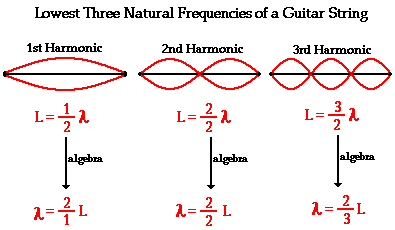Harmonics
In the
guitar world, the term 'harmonics'
gets tossed around a lot. To a guitarist, this term refers to a sound
that is made at certain places on the string. From a physics viewpoint,
harmonics refers to the natural frequency at which an object naturally
vibrates. Putting two and two together, a physicists analysis of
harmonics on a guitar would be the places that a guitar string
naturally
vibrates.

Several factors that determine a guitar strings' natural frequency are string tension, string length, and linear density. In fact, the wave equation can be used to determine a strings naturally frequency:

Several factors that determine a guitar strings' natural frequency are string tension, string length, and linear density. In fact, the wave equation can be used to determine a strings naturally frequency:
Speed =
(Wavelength)(Frequency)
Since there are multiple
harmonics on a guitar, there are different wavelengths per harmonic.
The picture above shows the relationship between the string length and
wave length of the first three harmonics (natural frequencies) of a
guitar string. In theory, if you knew a particular harmonics frequency
and the speed at which the string vibrates (at that frequency), you
could determine where on the guitar this position is!!